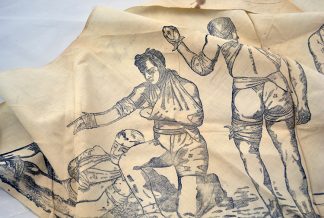From the Curator
We have over 1,000 medical artifacts from the 19th and 20th centuries within our collection at the Wangensteen Historical Library of Biology and Medicine — from medical and scientific instruments to glass eyes to traveling pharmaceutical kits. Along with rare printed materials, artifacts are used in object-based learning to engage, enrich and energize teaching, learning and research.
As we work to catalog our artifact collection, we often re-discover interesting tools of medicine’s past. One such item is our Seabury and Johnson Bandage Kit that was recently featured in a post by Maria Null in the Johns Hopkins “Recommended Dose” blog. This kit was cataloged by Katie Otto, who has been working at the Wangensteen Historical Library for the last three years.
Katie will be moving to another job within the University of Minnesota Libraries. Before she leaves, I am sharing her experience cataloging artifacts as a way to celebrate her contributions. I hope that you enjoy this behind-the-scenes look.
Lois Hendrickson, Curator
Wangensteen Historical Library of Biology and Medicine
What it’s like doing artifact research
By Katie Otto
For the past three years I’ve been working with the vast artifact collection in the Wagensteen History of Medicine and Biology Library. The collection consists over 1,000 medical and dental artifacts. I was only able to work with a small fraction of the collection, but during this time I discovered some extremely fascinating items. I have learned a lot — not only about history and uses of these artifacts — but how the research process for artifacts works as well.
Re-discovering the past
The last artifact I worked with was a Seabury and Johnson Bandage kit from 1906. What is wonderful about this artifact is that most of the items are still intact and appear to have never been used.
The kit contains several items that were commonly used for treating wounds and broken bones then, but that you would never think of using today.
For example, the kit has a small bottle of hypodermic whiskey. It is hard to imagine in today’s world injecting a syringe full of whiskey into an injured patient. Another example is an empty bottle of mercury bi-chloride, a highly poisonous chemical, which was used to prevent infections before antibiotics existed.
About the process
For every artifact I researched, I attempted to discover its use, the material it was made of, and the time period when it was used.
One of the challenges faced when researching artifacts is not knowing who manufactured the device. This makes it difficult to determine the time period when the device was used. Fortunately, the bandage kit included the manufacturer and date.
Another challenge when researching these artifacts is how time consuming the process can be. It is more than just typing the name of the artifact in the library catalog, your favorite database, or Google. Much of the process requires reading through old journal articles, textbooks, and old manufacturing or drug catalogs. Older articles and textbooks can also be difficult to read as the writing was often narrative, wordy, and told from the perspective of one physician.
When mysteries remain
Even when you know the manufacturer and time period, it can still be difficult to learn how the artifact was once used. I ran into this issue a handful of times. For example, the Seabury and Johnson kit contained a small bottle of liquid ammonia.
After much research, I was unable to determine the exact intention for the liquid ammonia. Thus, I made an educated guess based on the information I was able to find. I assumed it was used for cleaning medical equipment and surfaces. I did, however, find one source from the late 1800s that stated that an injection of liquid ammonia was used to treat snake bites.
Hidden treasures
One of the best experiences with artifact research is coming across “jaw-dropping” items. For example, the Seabury and Johnson kit contains a beautifully illustrated, intact triangular Esmarch bandage. The triangular bandage was popularized in the late 1800s by surgeon Friedrich Esmarch, who suggested printing illustrations of use directly on the bandage. These bandages soon became staples in first aid kits.





